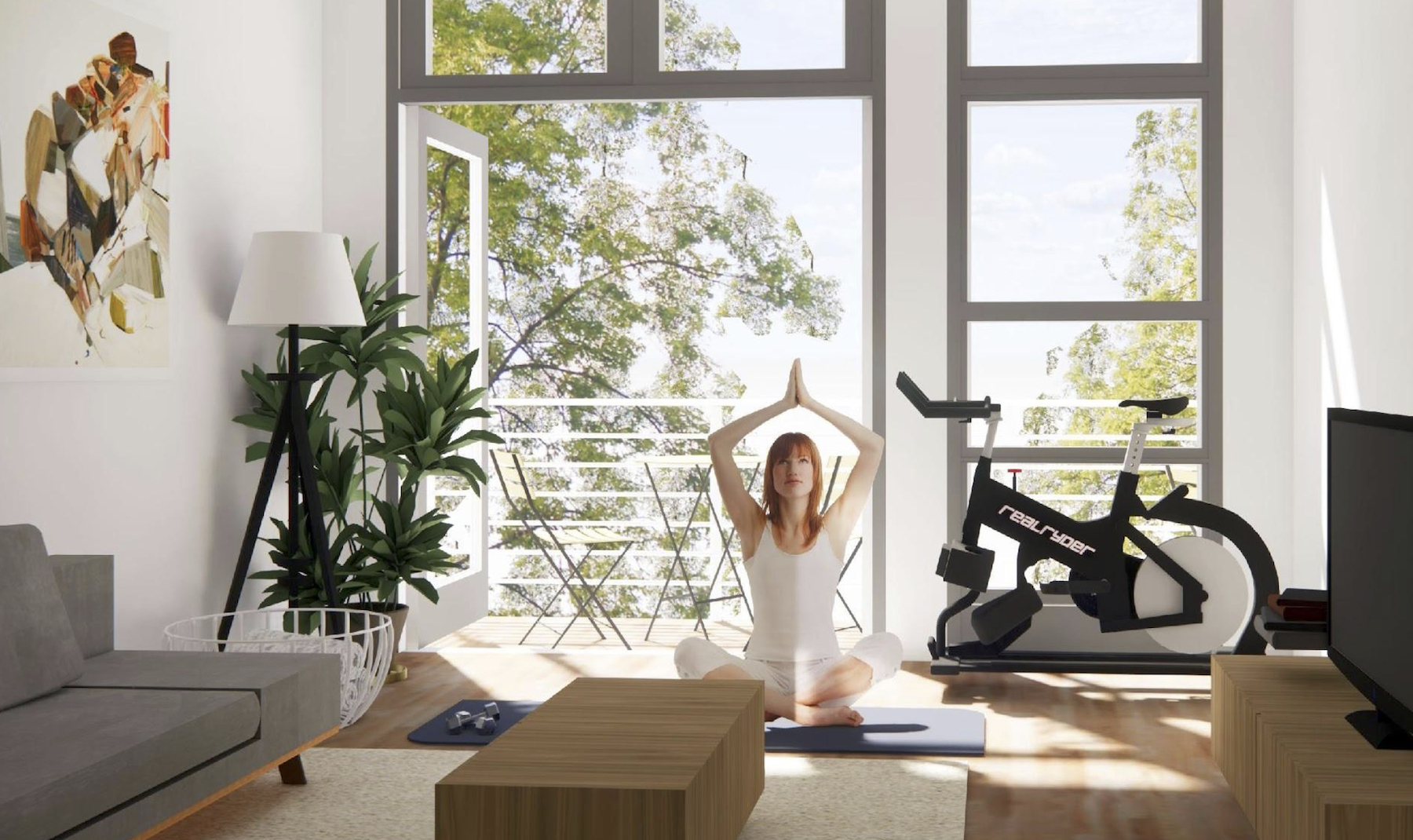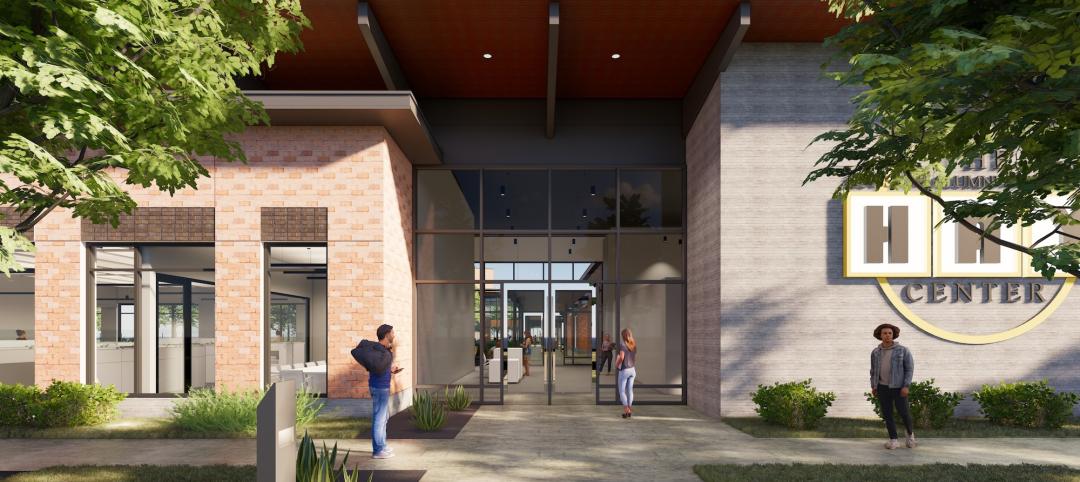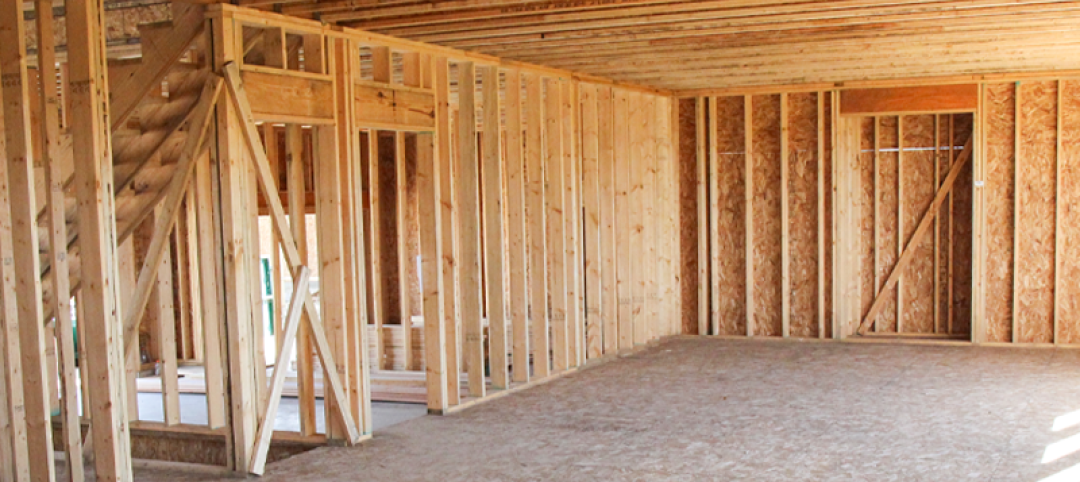Nearly 40 million Americans live in apartments. And because of the COVID-19 pandemic, developers and residents have been forced to rethink apartment living in terms of health, space, and utility.
To capture these thoughts, and to understand the future of multifamily housing, a team at Grimm + Parker Architects, which specializes in affordable and sustainable architecture projects, last summer conducted a fact-based exploration of the challenges and pressures that developers and residents experienced during the health crisis, and how those factors are likely to affect apartment design.
Other design firms have speculated on the impact COVID-19 is likely to have on apartment living, but far fewer have provided solutions as specifically as Grimm + Parker.
The following article is based on the report that came out of that firm’s exploration, titled “The New Normal and the Future of Multifamily Housing,” and created from responses of a dozen developers and 91 residents in the Washington, D.C.–Maryland–Virginia markets. This article also draws from commentary from three Grimm + Parker design architects—Zak Schooley, AIA, LEED AP BD+C, Executive Vice President; Julio Cruz, Architectural Designer; and Lauren Gilmartin, Architectural Designer—whom BD+C interviewed last December.
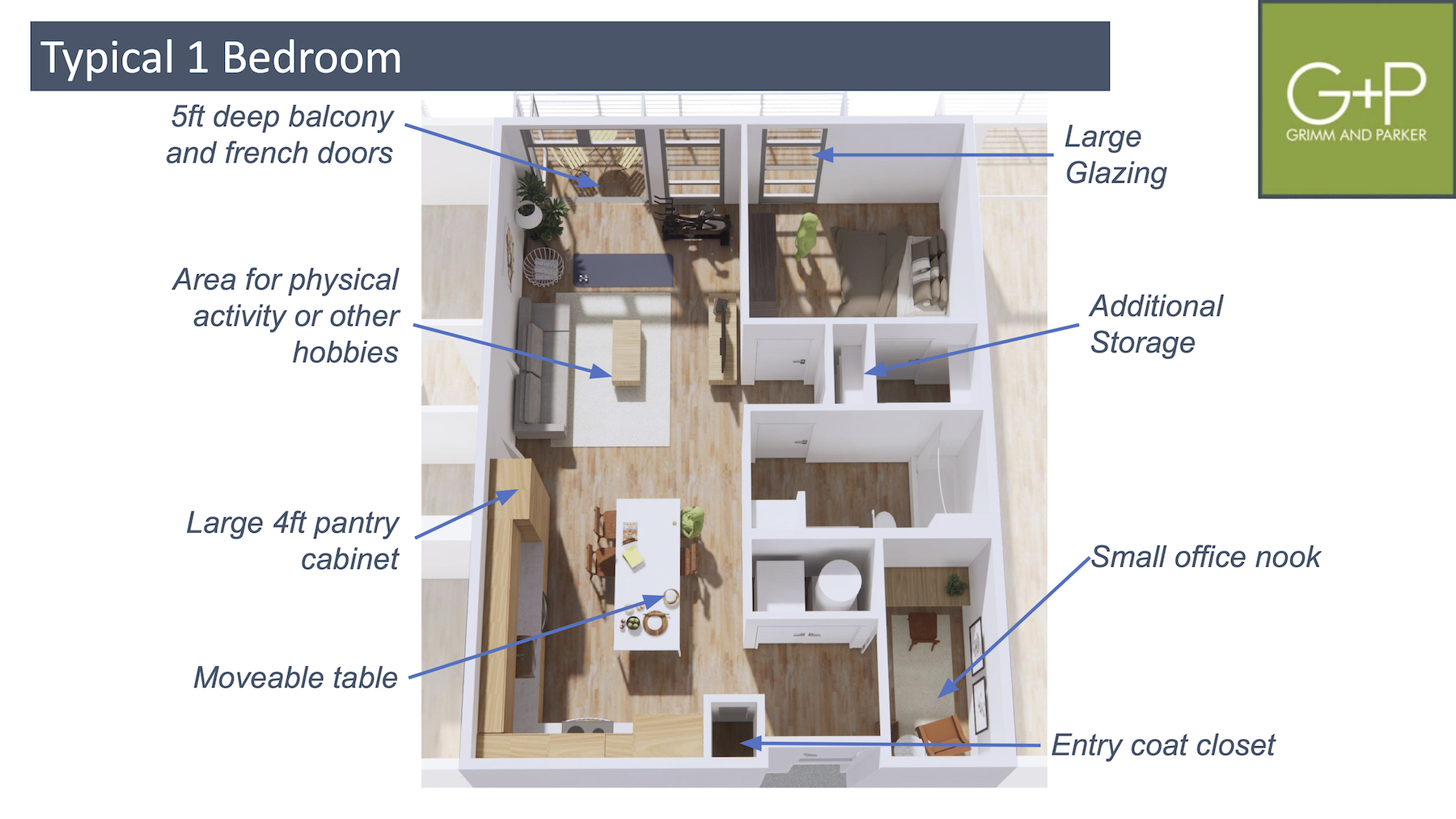
Storage, moveable furniture, and more space for physical activities, both in- and outdoors, could define the apartment of the future. Rendering Grimm + Parker
The vast majority of the survey’s respondents—92%—saw the social and physical implications of COVID-19 as being at least moderate, and in some cases significant. “Quarantine is difficult enough, but the added noise from other residents makes it so much more difficult. I can hear doors slamming, cabinets slamming, constant thuds from neighbors above, dogs barking. It wears on mental sanity,” said one exasperated resident whom the report quoted. Download a PDF recap of the Grimm + Parker multifamily research report, The New Normal & The Future of Multifamily Housing.
Schooley pointed out that there was a lot of concern expressed about health and safety, and the increasing density of apartment projects, which complicated social distancing and the ability of residents to “separate” rooms within apartments for different uses. And 80% of residents indicated a shift in desired residential unit types, which was a disconnect in developer thinking.
Common challenges cited by respondents included the lack of adequate space while sheltering-in-place, to live, work, and exercise. Only 11% of the resident-respondents lived in an apartment with a balcony, so quarantine made access to the outdoors problematic. Conversely, those respondents with balconies were able to adapt that space for, say, fitness or meditation.
The quarantine sometimes required residents to make purchases, like paper goods and cleaning products, in quantities that otherwise might seem extraneous. Many of the survey’s respondents had to come up with makeshift storage solutions by purchasing shelving or creating “contaminated” storage areas for wallets, keys, and bags.
SEEKING SPATIAL FLEXIBILITY IN MULTIFAMILY UNITS
In its report, Grimm + Parker suggested myriad design changes for a typical 733-sf one-bedroom apartment. “With the projected success of the work-from-home business models, residents will need their units to become more versatile and adaptable, to provide users with enhanced technology, spatial flexibility, and separation, as well as provide adequate mental relief through connection to the outdoor environment and fresh air,” the report stated.
The firm highlighted changes that included five-foot-deep balconies and French doors; larger glazing for natural light; physical areas for activities and hobbies; four-foot-deep pantry cabinets; moveable tables; and additional storage.
Schooley noted that tenants also need places where they can “isolate,” even if for a short spell.
BIGGER AMENITIES SPACES FOR APARTMENT BUILDINGS
The report touched on how COVID-19 has altered tenants’ and developers’ perceptions about an apartment building’s amenities. For example, 80% of users said it was a challenge maintaining social distancing while exiting their buildings. More than 30% cited issues with the building’s cramped laundry rooms or package collection areas. And 91% said they’d be changing the way they use amenity spaces in the future.
Two-thirds of the developers who responded to the survey indicated they would like to see amenity spaces adjusted to fit social distancing standards and improved hygiene protocols. Elevators, lobbies, laundry rooms, and grocery pick-up zones were among the most mentioned spaces.
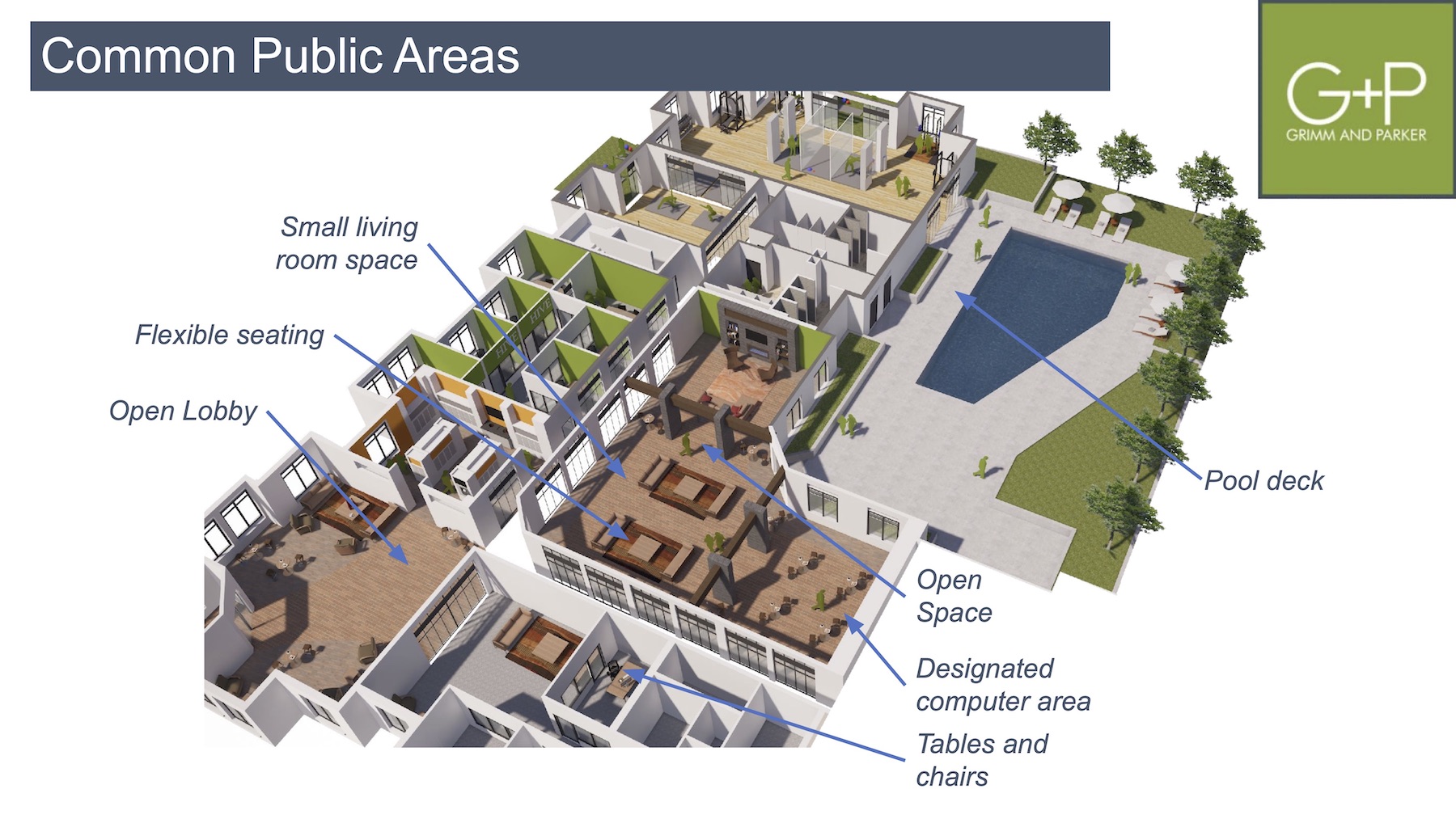
The common public area envisioned by this case study would include more compartmentalization, designated spaces, and flexibility. Rendering Grimm + Parker
Cruz said that Grimm + Parker looked at how residents had been coping with COVID-19 to maintain some semblance of work-life balance, another key tenant concern. With that in mind, changes to common public spaces, said the report, should incorporate more offices and designated computer lounges, flexible seating, an open lobby, a pool deck, and a small living-room space. Common areas should also have operable doors that provide flexibility to size different rooms.
The report singled out how to make fitness rooms safer by enlarging them with an open floor plan. These areas should offer hand-sanitizing stations and designated spaces for individual and group exercise that include outdoor options. Operable doors would introduce more fresh air into the indoor space and allow for flexibility to scale rooms according to usage and need.
ONLINE PURCHASES OVERWHELMED MULTIFAMILY BUILDINGS
The pandemic exposed the inability of apartment buildings to handle the sheer number of packages they were receiving as a result of their tenants’ online purchases. (Digital Commerce 360 estimates that online spending in the U.S. rose 44% to $861 billion in 2020, and accounted for 21.3% of total retail sales last year.) Gilmartin noted that most buildings’ mail rooms, pre-pandemic, weren’t large enough or equipped to handle big packages or grocery deliveries.
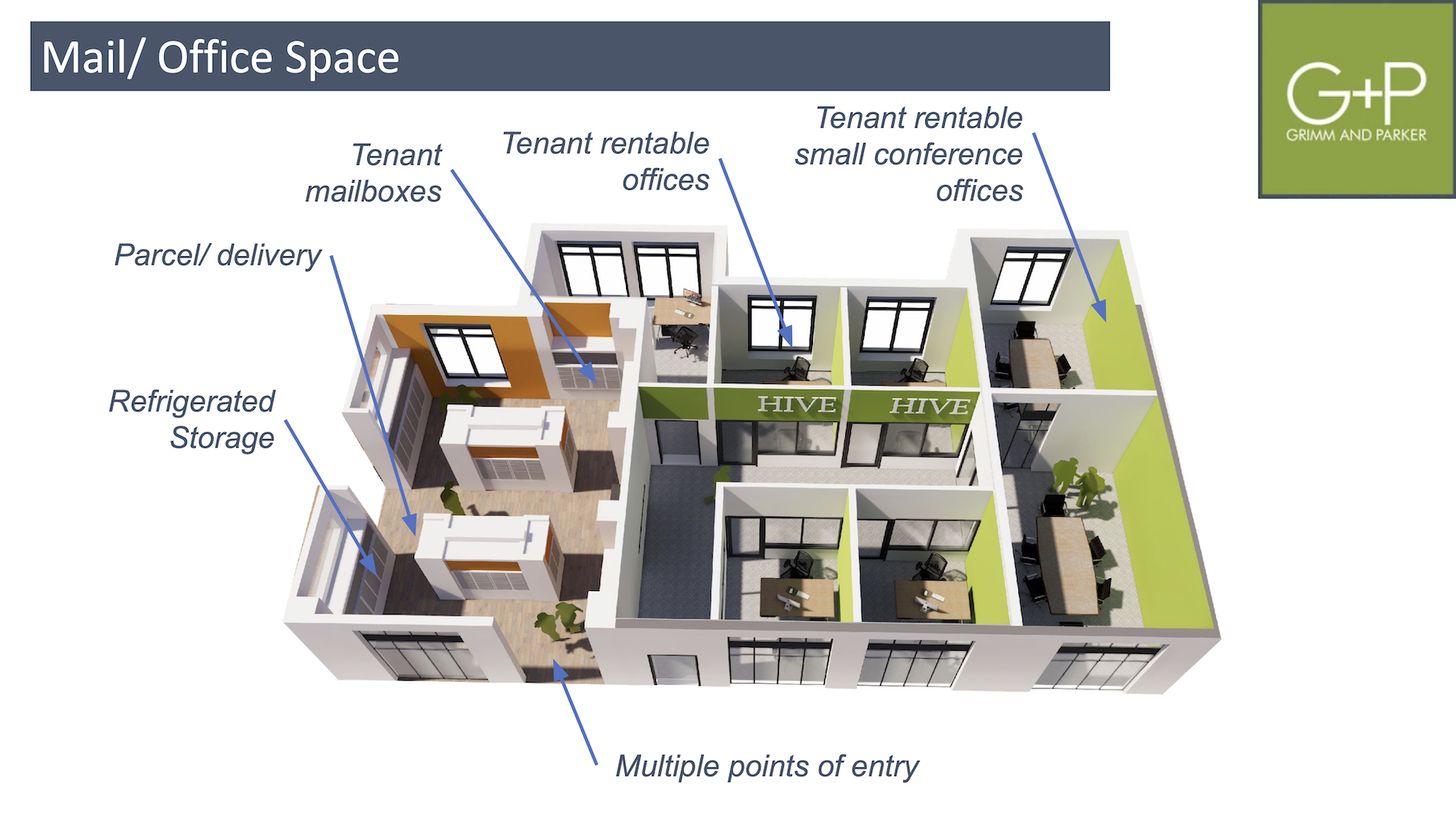
Rendering: Grimm + Parker
Grimm + Parker foresees the multifamily building of the future with electronic refrigerated storage and ample package pickup spaces. The firm also envisions mailrooms with tenant boxes that combine with rentable office and conference room space. The area, in this vision, would have multiple points of entry.
Such an environment might also benefit from individualized mechanicals and airflow zoning for each space.
Schooley says he could imagine tenants renting space just to get out of their apartments for a while to complete a project, or to give their kids cooped up in the apartment because of quarantine a temporary change of scenery.
Related Stories
Senior Living Design | Aug 7, 2023
Putting 9 senior living market trends into perspective
Brad Perkins, FAIA, a veteran of more than four decades in the planning and design of senior living communities, looks at where the market is heading in the immediate future.
Multifamily Housing | Jul 31, 2023
6 multifamily housing projects win 2023 LEED Homes Awards
The 2023 LEED Homes Awards winners in the multifamily space represent green, LEED-certified buildings designed to provide clean indoor air and reduced energy consumption.
MFPRO+ New Projects | Jul 27, 2023
OMA, Beyer Blinder Belle design a pair of sculptural residential towers in Brooklyn
Eagle + West, composed of two sculptural residential towers with complementary shapes, have added 745 rental units to a post-industrial waterfront in Brooklyn, N.Y. Rising from a mixed-use podium on an expansive site, the towers include luxury penthouses on the top floors, numerous market rate rental units, and 30% of units designated for affordable housing.
Affordable Housing | Jul 27, 2023
Houston to soon have 50 new residential units for youth leaving foster care
Houston will soon have 50 new residential units for youth leaving the foster care system and entering adulthood. The Houston Alumni and Youth (HAY) Center has broken ground on its 59,000-sf campus, with completion expected by July 2024. The HAY Center is a nonprofit program of Harris County Resources for Children and Adults and for foster youth ages 14-25 transitioning to adulthood in the Houston community.
Adaptive Reuse | Jul 27, 2023
Number of U.S. adaptive reuse projects jumps to 122,000 from 77,000
The number of adaptive reuse projects in the pipeline grew to a record 122,000 in 2023 from 77,000 registered last year, according to RentCafe’s annual Adaptive Reuse Report. Of the 122,000 apartments currently undergoing conversion, 45,000 are the result of office repurposing, representing 37% of the total, followed by hotels (23% of future projects).
Multifamily Housing | Jul 25, 2023
San Francisco seeks proposals for adaptive reuse of underutilized downtown office buildings
The City of San Francisco released a Request For Interest to identify office building conversions that city officials could help expedite with zoning changes, regulatory measures, and financial incentives.
Sponsored | Multifamily Housing | Jul 20, 2023
Fire-Rated Systems in Light-Frame Wood Construction
Find guidance on designing and building some of the most cost-effective, code-compliant fire-rated construction systems.
Multifamily Housing | Jul 13, 2023
Walkable neighborhoods encourage stronger sense of community
Adults who live in walkable neighborhoods are more likely to interact with their neighbors and have a stronger sense of community than people who live in car-dependent communities, according to a report by the Herbert Wertheim School of Public Health and Human Longevity Science at University of California San Diego.
Affordable Housing | Jul 12, 2023
Navigating homelessness with modular building solutions
San Francisco-based architect Chuck Bloszies, FAIA, SE, LEED AP, discusses his firm's designs for Navigation Centers, temporary housing for the homeless in northern California.


